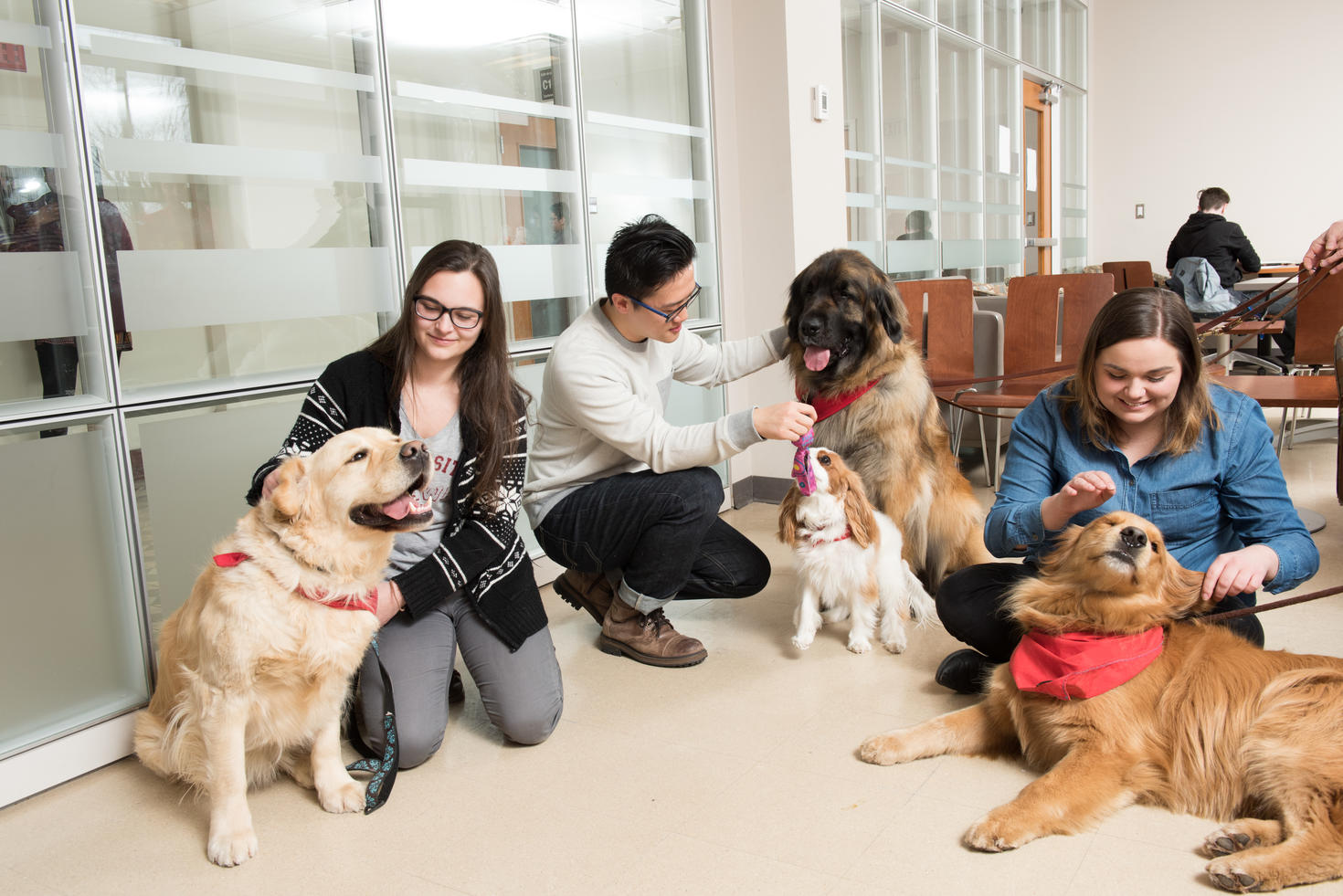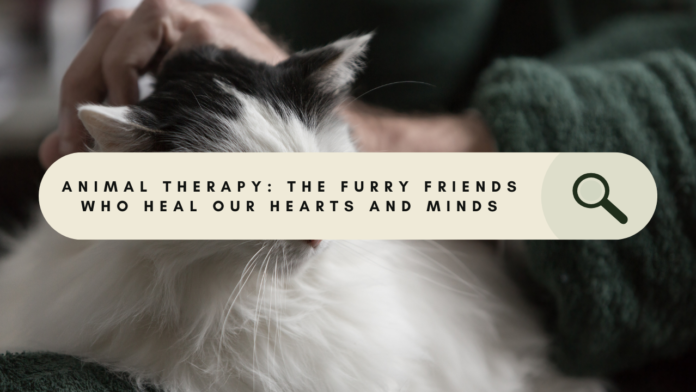Last Updated on April 30, 2024 by Dog Lover
Animal Therapy: The Furry Friends Who Heal Our Hearts and Minds
Have you ever felt the world melt away as you stroked a purring cat or watched a playful dog wag its tail?
It’s no secret that animals have a calming effect on us. But what if we told you that this furry magic can be harnessed to improve our mental and physical well-being?
Enter the fascinating world of animal therapy, a practice that utilizes the human-animal bond to promote healing and growth.
In this comprehensive guide, we’ll delve into the wonderful world of animal therapy.
We’ll explore how it works, the conditions it can help with, the different types of therapy animals, and the science behind the heartwarming connection between humans and creatures great and small.
So, buckle up, animal lovers (and even the slightly skeptical ones!), because we’re about to embark on a journey that might just change your perspective on the power of our furry (or feathery, or scaled) friends.
:max_bytes(150000):strip_icc()/animaltherapy-a6e253e0888a4b7e8197501e6428f4b0.jpg)
What is Animal Therapy?
Animal therapy, also known as pet therapy or animal-assisted therapy (AAT), is a form of complementary therapy that incorporates trained animals into a treatment plan.
These special companions provide comfort, emotional support, and motivation to individuals coping with various physical, mental, and social challenges.
Think of a therapy animal as a furry therapist’s assistant. They don’t dispense medication or analyze your dreams, but they offer something equally valuable: unconditional love and acceptance.
This non-judgmental presence can significantly improve a person’s mood, reduce anxiety, and foster a sense of well-being.
How Does Animal Therapy Work?
The human-animal bond is a powerful force.
Interacting with animals can trigger the release of oxytocin, a hormone associated with feelings of love, trust, and bonding.
This hormonal shift can lead to several positive benefits, including:
- Reduced stress and anxiety: Stroking a soft fur coat, listening to a calming purr, or simply gazing into an animal’s eyes can have a profoundly calming effect.
- Increased social interaction: Animals can act as social bridges, encouraging interaction and conversation between people who might otherwise feel isolated.
- Improved mood: Playful interactions with animals can trigger the release of endorphins, natural mood elevators that leave us feeling happy and content.
- Enhanced motivation: Therapy animals can provide a sense of purpose and responsibility, especially for individuals struggling with depression or low self-esteem.
- Boosted physical health: Studies suggest that interacting with animals can lower blood pressure, improve heart health, and even reduce pain perception.

Who Can Benefit from Animal Therapy?
Animal therapy can be a valuable tool for people facing a wide range of challenges. Here are some examples:
- Mental health conditions: Anxiety, depression, post-traumatic stress disorder (PTSD), and eating disorders can all benefit from the calming and supportive presence of a therapy animal.
- Physical health conditions: Individuals recovering from strokes, heart attacks, or chronic illnesses can find comfort and motivation from animal therapy.
- Developmental disabilities: Children with autism spectrum disorder (ASD) can experience improved social interaction and communication skills through animal therapy sessions.
- Learning disabilities: The unconditional acceptance and non-judgmental space provided by therapy animals can help children with learning disabilities feel more confident and engaged in their therapy.
- Elderly care: Seniors living in care facilities can experience reduced loneliness, depression, and anxiety through interactions with therapy animals.
:strip_icc()/pet-therapy---senior-woman-with-rabbit-at-home-524285131-5ba40507c9e77c005044af88.jpg)
The Different Types of Therapy Animals
While dogs are often the first animals that come to mind when we think of animal therapy, a surprising variety of creatures can be trained for this role.
Here are some of the most common therapy animals:
- Dogs: Loyal, loving, and endlessly trainable, dogs are the most popular choice for animal therapy. Their playful nature and eagerness to please make them ideal companions for children and adults alike.
- Cats: These independent felines might surprise you with their therapeutic abilities. Their gentle purring and rhythmic breathing can have a calming effect on people experiencing anxiety or stress.
- Horses: Equine therapy, which involves interacting with horses, can be particularly beneficial for individuals with physical challenges or emotional trauma. The act of caring for and riding a horse can build confidence, improve physical coordination, and foster a sense of accomplishment.
- Rabbits: Small, fluffy, and surprisingly social, rabbits can provide a gentle and calming presence for people of all ages.
- Birds: The chirping and colorful plumage of birds can be a source of joy and stimulation for people experiencing dementia or other cognitive challenges.
The Science Behind the Benefits
While the human-animal bond has been celebrated for centuries, science is now catching up to what pet owners have always known: animals have a real and measurable impact on our well-being.
Here are some of the scientific studies that support the use of animal therapy:
- Reduced Stress and Cortisol Levels: A study published in the journal “Psychoneuroendocrinology” found that interacting with therapy dogs lowered cortisol levels, a key stress hormone, in participants.
- Improved Social Interaction in Autism Spectrum Disorder (ASD): Research published in the “Journal of Autism and Developmental Disorders” showed that children with ASD engaged in more social interaction and communication after participating in animal therapy sessions with dogs.
- Lower Blood Pressure in Patients with Heart Disease: A study in the journal “American Journal of Cardiology” demonstrated that interacting with therapy animals led to a decrease in blood pressure for patients recovering from heart attacks.
These are just a few examples, and research on the benefits of animal therapy is ongoing.
However, the growing body of evidence suggests that our furry (or feathery, or scaled) friends can play a significant role in promoting mental and physical health.

Finding an Animal Therapy Program
If you’re interested in experiencing the benefits of animal therapy for yourself or a loved one, here are some steps you can take:
- Talk to your doctor or therapist: They can help you determine if animal therapy is a good fit for your needs and recommend qualified programs in your area.
- Research local organizations: Many hospitals, nursing homes, and mental health facilities offer animal therapy programs. You can also search online for pet therapy organizations in your area.
- Ask about credentials: Ensure the program uses certified therapy animals and handlers who have undergone proper training.

Important Considerations
While animal therapy offers a wealth of benefits, it’s important to consider a few things before diving in:
- Allergies: If you have allergies to animal fur or dander, animal therapy might not be the right fit for you.
- Animal phobias: Some people experience fear or anxiety around animals. If this is the case, discuss alternative therapy options with your doctor.
- Animal behavior: Therapy animals are carefully screened and trained, but it’s still important to be respectful of their boundaries and comfort levels during interactions.

The Human-Animal Bond: A Powerful Connection
Animal therapy is a powerful tool that harnesses the unique bond between humans and animals to promote healing and growth.
From reducing stress and anxiety to fostering social interaction and motivation, the benefits of animal therapy are undeniable.
So, the next time you’re feeling down or simply need a furry pick-me-up, consider reaching out to a local animal therapy program.
You might just be surprised by the positive impact a four-legged (or winged, or scaled) friend can have on your well-being.
FAQs
Can I get my own pet certified as a therapy animal?
While some pets may have the temperament and training to become therapy animals, it’s important to go through a formal certification process. This typically involves evaluations by veterinarians and animal behaviorists to ensure your pet is suitable for therapeutic work.
Is animal therapy covered by insurance?
Some insurance companies may offer partial or full coverage for animal therapy sessions. It’s best to check with your individual provider to determine their specific coverage policies.
Are there any risks associated with animal therapy?
The biggest risk associated with animal therapy is the potential for allergic reactions. It’s crucial to disclose any allergies you have before participating in a program. Additionally, it’s important to be respectful of the therapy animal’s boundaries and avoid any behavior that might stress or frighten them.
What are some alternatives to animal therapy?
If animal therapy isn’t a good fit for you, there are several alternative therapy options available. These include music therapy, art therapy, and mindfulness meditation.
Where can I learn more about animal therapy?
Several reputable organizations provide information about animal therapy, including the Pet Partners Therapy Association (https://petpartners.org/) and the American Humane Society (https://www.aspca.org/).










